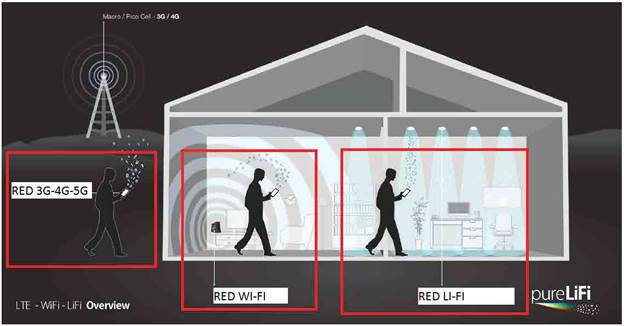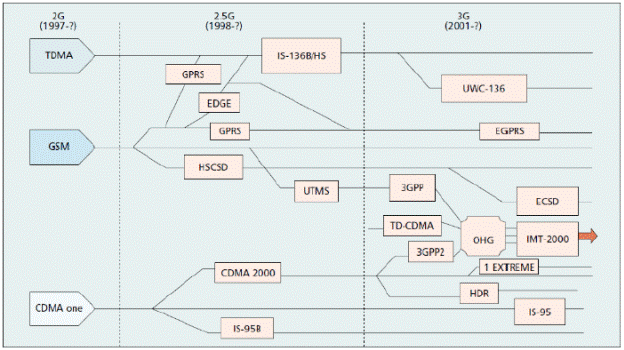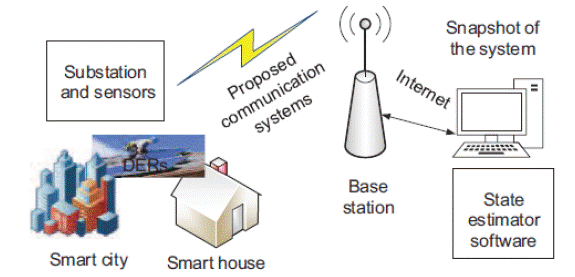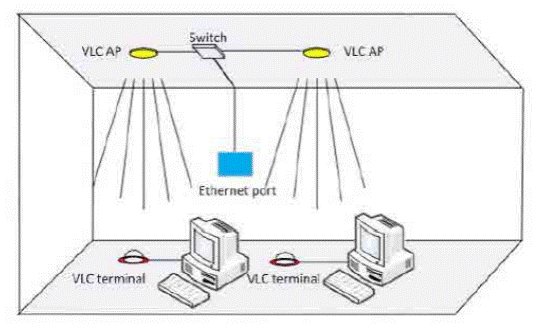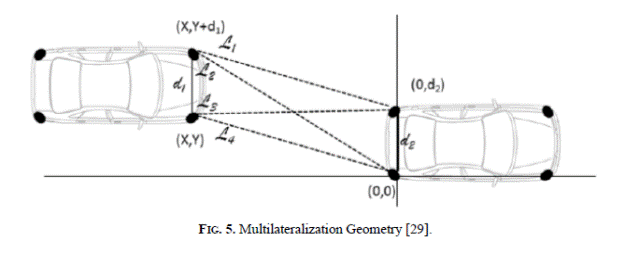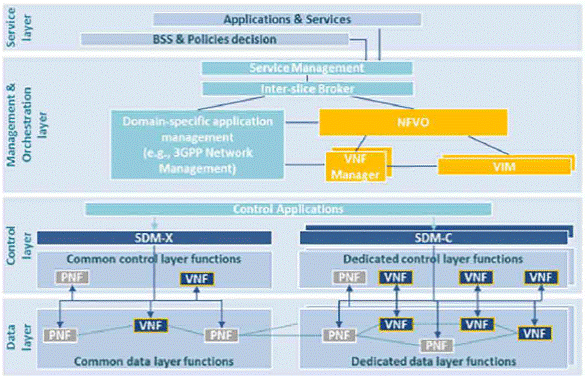I. Introduction
Currently, the traditional Radio Frequency (RF) wireless networks are increasing, making possible the integration with technologies that provide increased bandwidth and agile responses 1. Technologies and mechanisms are available, presenting the need for coexistence and interoperability, in this case, traditional networks of RF and Light Fidelity (Li-Fi).
Wireless networks statistics indicate that by 2014 the world mobile traffic had grown approximately up to 70 %, and that only 26 % of the total world smartphones are responsible for 88 % of the total data traffic in mobile networks. These considerations show that there is a need to review with special attention the current demand for real-time services that require future networks to include aspects of mobility, in accordance with the user's requirements 2. Forecasts of the Cisco Visual Networking Index (VNI) indicate that by 2019 more than half of the devices that will connect to a network will be smartphones. The increased use of smartphones is closely related to the exponential increase in mobile traffic (multimedia). In fact, since 2012, the video traffic is more than half of the global mobile traffic. By 2020, it is expected that an average user will download around 1 terabyte of data on an annual basis. In addition, Cisco researchers predict that the worldwide mobile data traffic for the period between 2014 and 2019 will be dominated by the transmission of video 3.
One of the services that require high quality data transmission is undoubtedly the video, which has been discussed on LTE (Long-term evolution) networks 4. One of the used mechanism, focused on delivering a minimum quality of service without requiring high levels of processing, consists in sequentially grouping pictures into frames without speed dials and retransmit only when times of transmission are set to expire, in which the frames have not been received. This little interest in offering a good quality of service should become a major effort for the 5th generation networks, in which the budget of band widths, minimum latencies, and high coverage for any connectivity (Anywhere - Anytime) generate a great service demand on the communications platform. From the point of view of Li-Fi networks, there is an opportunity to integrate visible light communication (VLC) and conventional systems of traffic treatment traffic, based on the challenges of the 5th generation networks.
In today's world, wireless communications handle such high percentage of users and information that focusing efforts in research and innovation is crucial in this sector of technology. The major telecommunication operators aim their initiatives at meeting the high demand needs of all markets and industries. Technologies of 4th and 5th generation are present in most countries, however, some of their advantages have not been used in the best way. Consequently, it is of vital importance to start working on analyses and evaluations focused on obtaining the requirements of the networks and their integration, which is a fundamental feature that provides a greater bandwidth and processing possibilities of decentralization.
At this point, it is important to understand the concept of indoor VLC, in which using light emitting diodes as transmitters provides a link with high levels of SNR, which is ideal for video transmission. The LED light illuminates their own attocell and transmits video flows on a downlink to multiple mobile terminals 5. In general, they are handled in three different schemes: the unit of reused frequency, the transmission based on a factor of reused high frequencies, and the transmissions in vector. An example of VLC and integration with RF networks is shown in Fig. 1.
VLC systems have several benefits such as the security of the inherent information, a vast bandwidth in the spectrum that does not require licensing, and a low cost of LED diodes and photodetectors, among others 5.
II. Studies of Load Balancing and QoS
In terms of computer architecture, load balancing is defined as the distribution of workloads across multiple computing resources. This balancing load helps optimizing the use of resources to improve performance, minimize response time, and avoid the overload of any system component. In this context, an availability option is presented through the redundancy of components and services 6.
In terms of telecommunications and networks, load balancing is commonly used in the redundancy of communication links. This mechanism allows communication devices, servers, routers, access point, etc., to use multiple paths to send data to a destination. In this process, the telecommunication devices analyze the information with respect to the metrics that have been stored, and make decisions based on the best transit route. If the metrics are the same for multiple links, load balancing allows the system to manipulate them and obtain the highest performance in terms of traffic data 7.
For the Internet of things (IoT), for example, the RF spectrum is currently limiting the user's speed, hence, for this case, load balancing becomes a viable option. The integration of Li-Fi and RF networks has been suggested in order to take advantage of the visible light spectrum, in terms of the speed and the coverage guarantees of the RF. Wang et al. (8 stated that a load balancing algorithm allows users to be autonomous in the selection of the Access Points (APs) according to their needs. This decentralized proposal will allow a process download of the central units 8.
According to the increasing possibilities with the IoT, in the future, there would be up to 20 objects per person connected through this concept, which will make necessary to consider increasing the bandwidth for its proper functioning. With the Li-Fi hybrid proposal, the increase of speed is remarkable, achieving up to 100 Gb/s, not to mention that there is no interference with respect to the RF, because the signals handle different portions of the spectrum. However, the line of sight in Li-Fi would present a problem in its implementation, since losing it would decrease the speed, but at the same time, the proposed hybrid in these cases would make the AP of RF services available for users.
Regarding the system details, for the Li-Fi part, the LED transmitters are established with low power and photodetectors in the receptors, with a perpendicular angle of radiation. Since this type of transmission requires a line of sight, which is normally blocked by walls, this block is used to reuse the frequencies in various cells. In regard to the conventional network of RF, the APs use different frequencies.
For the LTE and WiMax networks, the mandates of the UTI concerning Next Generation Networking (NGN) are oriented to both horizontal and vertical mobility support. In the current definition of interfaces, the two 4G technologies (LTE and WiMax) have introduced layers of quality services maps based on the dependence to the technology access. It has been proposed to provide some framework of quality of service, with an optimum traffic classification and efficiency for end-to-end interoperability for a unified WiMax-LTE network. In simulation scenarios of the interconnection between WiMax and LTE, the frameworks performance has been tested with traffic transmission in real and not real time, and in isolated and mixed environments. The results of these simulations showed that it is possible to provide the quality of service needed for end-to-end communications, according to the traffic requirements of the applications 9.
III. Legacy of 3G and 4G, and Panorama of 5G
The third generation of networks and services, at the time, came to offer opportunities in terms of multimedia applications and services that fit the quality needs for the end-to-end communications. The main parts of the standards were aligned, and the 3G services started, but while the 3G evolution occurred, some operators continued implementing interim solutions of 2.5G for a period of time. Fig. 2 shows several scenarios of evolution from 2G to 3G networks and the architecture of QoS for UMTS and their requirements 10.
At the time, 3G was defined as a mobile multimedia, personal service, and as the convergence of digitalization, mobility, internet, and new technologies based on global standards. With 3G, the end user would have the possibility to access their mobile internet with a bandwidth (on demand) from hundreds of kilobits per second up to 2 Mb/s. Furthermore, Guo et al. (10) believed that 3G was the business opportunity for the 21st century.
It is estimated that the capabilities of mobile networks will increase by a factor of 1000, without taking into account the devices present in IoT (11); therefore, candidate solutions from the point of view of 5G networks include the following: 1) greater densification with less management of the base stations, which should be able to connect multiple radio access technologies (12); 2) the use of different MIMO arrangements (multiple antennas per base station) (13); 3) the use of wavelengths in the order of millimeters (frequencies between 3 and 300 GHz) to take advantage of the bandwidth in these frequencies (14); 4) D2D communication, in which the predictions for 5G are estimated based on the speed requirements in the order of GB/s per users, with very low latency and high efficiency in the management of the device's battery life; the D2D connections would download cellular traffic from the base stations through the WFD (Wi-Fi Direct) links (15); 5) Full Duplex (FD) wireless using the same frequency band, which requires handling the devices auto-interference (16,17).
For 4G networks, in the mobile telephone service (MTS), the mobile phones are connected to the public switched telephone network (PSTN) to other mobile phones or even to other communication systems, such as the internet. A cellular system divides large geographical areas into smaller areas called cells. Each cell is covered by a base transceiver station (BTS), in which one or multiple transmitters and receivers communicate with the mobile phones located within the area. Each BTS determines a cell and all of them form the coverage area. The stations or mobile phones connect with the base stations through radio channels. The receivers convert these radio signals into electrical signals so that they can be sent to the mobile switching center (MSC), also known as mobile switching station. The MSC adapts the signals that come from the base station in such a way that they could connect to other BTS, to the public telephone network, or log into the databases that contain the user's information. The mobile switching center is part of the cellular network that receives all requests for services and makes the necessary procedures to establish and maintain communications (18).
A relevant point in the 4G networks is the energy and the performance of the user, factors that represent a fundamental point that may improve through the combination of antenna muting algorithms and the reconfiguration of three dynamic sectors, which become psi-omnidirectional. You can determine a detailed algorithm to change to a time scale of sub-seconds, and to a mode of capacitive sector coverage MIMO (Multiple In - Multiple Out); and this, to a simple transmission antenna with a cover mode of psi-omnidirectional optimization for low power consumption. The performance evaluations, according to the E3F (Earth Energy Efficiency Evaluation Network) show that in a LTE network with national coverage, the greatest energy savings with the proposed algorithm are located in rural environments. Through the application of an antenna muting so dynamic, energy savings achieve 24.9 %, compared to the reference case without using the algorithm, and by combining the antenna muting and the psi-omnidirectional coverage, an energy saving of 43.8 % is reached. In the latter case, we experienced a drop in the user's average bit rate of 10.7 % when both algorithms were applied (the antenna muting and the dynamic reconfiguration of the omnidirectional sector) (19).
From the point of view of infrastructure, the attenuation of electromagnetic waves (EM) were experimentally investigated by constructing walls, focusing on the frequency range of 700 MHz-5 GHz. The results of this research can be used in planning inside radio coverage wireless access networks, such as 2G, 3G, 4G, Wi-Fi and future systems of 5G mobile phones, in the study of applications for satellite navigation, and in the evaluation of the exposition of residential populations to electromagnetic fields emitted by the radio base stations (RBS) of the mobile radio access network (RAN). The measurements were obtained using a portable vector network analyzer (VNA) connected to two antennas of Vivaldi light. Time domain methods were used to reduce the errors caused by multiple routes. The measurements of electromagnetic attenuation for walls were taken in different buildings; for example, in the city of Rome (Italy), measurements were taken in different types of constructions, such as historical buildings from the Roman Empire until the mid-19th century, and in modern reinforced concrete buildings. The effectiveness measurements (SE) showed shielding values of EM even higher than 80dB (20).
In respect to the base stations, it is expected that these can be integrated with Wi-Fi solutions, in order to increase the coverage range.
According to (21), the standards of cellular network techniques are added to address patterns as a result of the increase of IoT devices. This increase is demanding trends that allow a greater measure of interchange between applications and an increase in the interoperability. In addition, the rigid structure of the data models is migrating toward dynamic models, with the needs of the market and users. Other areas of standardization in which a strong interest is observed correspond to the security for IoT and connectivity for large areas with low power. Four major topics are classified in this way, in which the research requires a migration toward standards: Networking including 5G, semantic interoperability, and security and connectivity to wide areas with low power.
IV. IoT Applications on 5th Generation Networks
Given the significant concerns with respect to carbon emissions from fossil fuels, global warming and the energy crisis, renewable distributed energy resources (DER) will be integrated with intelligent networks, which will make the energy supply more reliable, reducing the cost and transmission losses (22). Unfortunately, one of the main technical challenges in planning, controlling, and operating a power system with DER is the voltage regulation at the distribution level. This problem stimulates the deployment of sensors and executors in intelligent networks with the final purpose of controlling at an acceptable level the voltage regulations. The information from multiple DER is transmitted to a control center via IoT based on 5th generation networks.
The communication infrastructure proposal offers an opportunity to address the challenge of voltage regulation with two-way communication links to collect, estimate, and control the state of microgrids. Based on this communication infrastructure, a minimum square of Kalman filter for the state estimation, and a control method of feedback for voltage regulation is proposed. Specifically, it is proposed to optimize the performance index using programming techniques semi defined in the context of smart networking applications. (22)
From the point of view of IoT, this application of energy is based on the possibility of integrating communications with heterogeneous devices, with a view in global platform for renewable energy. The 5th generation principles seek to enable new facilities, security, and high speeds for each service and device (22).
High speed data, low latency, improvement in the capacity of the base stations, and a better perception of QoS for users correspond to the 5G vision compared to LTE networks. The evolution of mobile networks from the exclusive voice traffic to the penetration packet of traffic has been accompanied by the evolution of technologies of physical layer access from WCDMA (Wideband Code Division Multiple Access) to MIMO and HARQ (Hybrid Automatic Repeat Request). Services oriented toward the mobile multimedia applications, such as video conferencing, video streaming, e-healthcare, and online games are increasing the user requirements and the business opportunities in the telecommunications sector for both operators and application developers 22.
Currently, in the wireless telecommunication environment, the concept of mm-wave is mentioned, which consists in using portions of the spectrum 3-300GHz, taking into account that the FCC opened certain frequency ranges of this spectrum for commercial use 22.
The relevant requirements provided by the research in the industry and the academia are the following:
Speeds in the order of 1 to 10 GB/s
Roundtrip latency of 1 ms
Considerable bandwidth by areas of coverage
Considerable quantities of connected devices. From the point of view of IoT, 5G networks should have the ability to connect thousands of devices
Perception of availability in the order of 99.999 %
100 % coverage for any (Anywhere-Anytime) connectivity
Reduction of the energy use by 90 %
Long battery life for the devices
For analysis purposes of QoS, the points to evaluate correspond to the requirements 2, 5 and 6 22.
At the end of this decade, according to analysts, 50 billion IoT devices will be connected to mobile networks. They will consume 1000 times more data than today's mobile devices, at a rate of 10 to 100 times faster than the existing networks can support. 4G networks have almost reached the theoretical limit of number of bits that can be included in a given amount of the spectrum, so some engineers have begun to look toward higher frequencies, where the use of radio is lighter. Samsung has estimated that the government regulators could release up to 100 GHz millimeter wave spectrum for mobile communications, around 200 times more than today's mobile networks. This excess of spectrum would allow higher bandwidth channels and higher data speeds. The wireless products that use millimeter waves already exist for the transmissions with a fixed sight line. A new indoor wireless standard known as WiGig will soon allow to transfer data between multi-gigabit devices in the same room 23.
On the other hand, the demand for spectrum has dramatically increased with the arrival of modern wireless application. The shared spectrum, considered as a critical mechanism for 5G networks, is viewed from the point of view of the shortage of spectrum and the range of high access speeds, guaranteeing the quality of service. From the perspective of licensed networks, the interference generated by all secondary users can be minimized. From the point of view of secondary networks, there is a need for network assignment for secondary users that in general terms should reduce interference, enabling the interaction of greater number of secondary users. Nowadays, it is possible to find selections of networks and channel assignment mechanisms, in order to increase revenues to accommodate secondary users by supplying their preferences, while respecting the primary network operator's policies. There are solutions with respect to the accumulated interference for licensed users and the amount that the users should pay for using primary network; these solutions focus on generating a low price for secondary users with a specific QoS, subject to the interference restrictions of the available network with free channels. The particle swarm and a modified version of genetic algorithm are used to support the solution to the problem outlined above 24.
Practical applications of communication systems with internet access have been designed through visible light 24. Examples of these systems have come to use visible light downlink with a range of 2 m. With a pre-emphasis technology, it is possible to achieve a transmission from 130 MHz to 3 dB. The physical layer is controlled through FPGA, which is the bridge between the media access control and the physical layer. From the test scenario, a computer can access the internet and play online with video resources. The maximum downlink speed is up to 30 Mb/s 24. An example of this scenario is shown in Fig. 4. In this scenario, a conventional RF network is integrated with Li-FI devices, and framed within visible light communications. VLC-type Access Point was designed with FPGA (Field Programmable Gate Array) to ultimately provide a conventional internet connection.
5G will not be a significant improvement over 4G. The four previous generations of cellular technology have broken paradigms as to their compatibility in retrospect. In fact, 5G would need a paradigm change that would include high carrier frequencies with massive bandwidths, extreme device densities at base stations, and unprecedented antenna numbers. However, unlike the previous four generations, 5th generation will be highly integrative: any 5G spectrum and air interface with LTE and Wi-Fi will be unified to provide universal coverage and user experiences with almost no limits. To support this, the core of the network must reach high levels of flexibility and intelligence, and spectrum regulation must be improved, as well as cost and energy efficiencies, which will bring increasingly critical considerations 25.
Finally, network densification should be included within a 5G analysis as a key mechanism for the evolution of wireless networks over the next decade. Network densification includes densification over space (dense display of small cells) and frequency (using large portions of the radiofrequency spectrum in different bands). A cost-effective densification of space on a large scale is obtained with self-organized networks and efficient handling of interference between cells. The benefits of network densification can only be obtained if it is complemented by later technologies and includes the use of advanced receptors capable of canceling the interference 26.
V. Wireless Sensor Networks
For the purpose of testing a Li-Fi network on 5th generation environments, it is important to highlight one of the studies that have been carried out in various agricultural production sectors, due to the possibilities offered by using sensors that allow to determine the behavior of the signal as if they were regular cellular terminals.
Wireless Sensor Networks (WSN) are defined as a self-configurable feature network integrating a small number of node sensors also called motes, spatially distributed and communicated to each other for which radio signals are used to monitor and understand the physical world to control various conditions at different points, including temperature, sound, vibration, pressure, and movement of contaminants 27.
The name given to this type of device serves the purpose of indicating in a single word two of the main concepts: its small size and the idea that they can be distributed anywhere, which is possible thanks to the fact that they are autonomous devices that operate with batteries very similar to those of cell phones and can be charged by solar panels when required. In addition, their communications are based on protocols of low consumption as is the case of ZigBee 27. In an initial stage of signal recognition, this technology can be very useful to evaluate the performance of the network in certain fixed sites, which will later be validated on mobile locations.
VI. Safety environments and vehicular applications
One of the most relevant processes in the area of wireless network security is Radio Frequency Identification (RFID). This technology is used to identify an element, to follow its path of movement and to calculate distances thanks to a special label that emits radio waves, which is attached or incorporated into the object. RFID technology allows reading labels even when they are not in a direct line of sight and can also penetrate thin layers of materials (paint, snow, etc.). The radio frequency tag (Transponder, RFID tag) consists of a chip connected to an antenna, both contained in a label (RFID tag or RFID label). A device reads the tag and then captures and transmits the information. To facilitate the use of RFID for multiple applications that allow labeling and revoke some applications safely and efficiently, a secure RFID revocation request scheme is proposed in 28. Users are completely anonymous in the scheme. The proposed scheme can be used not only in multi-application of RFID tags, but also in a single application of a RFID tag. In addition, compared to other existing systems, the scheme provides a higher level of security and has an advantage of performance.
An implementation of the technology scheme is that the adoption of the hash function and a random number generate the corresponding module by using a typical challenge-response mechanism. The proposed scheme reduces the storage overhead and provides a higher level of security, ensuring a lower computational and labeling communication complexity throughout the protocol.
The scheme can achieve complete anonymity and facilitate the use of a multi-application RFID tag, in addition to securely and efficiently revoke some applications, according to the actual user's needs. Compared to other existing systems, the proposed system provides a higher level of security and has a performance advantage in terms of complexity. Finally, the proposed system can be used in the multi-application RFID tag to promote development in 5G 28.
It is important to mention that the IEEE 802.15.7 standard is about VLC communication, and defines network architectures, physical layer and medium access mechanisms. One of the main problems of Li-Fi is that it presents itself in the so-called hidden terminals 29. This refers to the loss of LOS (Line of sight) when an obstacle occurs between the transmitter and the receiver, or the angle of the receiving lens is limited. The way to counteract these effects is by adopting RTS/CTS (Request to send / Clear to send) or adopting free HT-protocols like MS-Aloha, which requires absolute synchronization. However, a standard solution is not currently identified. 29 Currently, there are analyses on the possibility of integrating Global Navigation Satellite System (GNSS) with Li-Fi networks, to increase accuracy over distances, for example, between two vehicles 29. The Time Difference of Arrival (TDoA) is measured with a technique known as multilateration, which consists in measuring the difference in terms of distance from stations with known positions that emit signals at the same time.
Fig. 5 shows the multilateration interaction in two vehicles for the integration between VLC and GNSS networks with a geometric approach.
VII. Network QoS
Regarding the quality of service in communication networks, IntServ (Integrated Services) is known since 1990, supporting the feature for end-to-end services. Resources were pre-reserved while traffic was being transferred between the two nodes. Resources were reserved according to the priorities of each new session. The packets should be processed at each intermediate node to locate the corresponding resources (30).
Differentiated services (Diffserv) were introduced to provide greater efficiency and less complexity in systems for extensive networks. Diffserv applies classification packets in the stand-alone computers on the network; it also provides end-to-end QoS, which is based on aggregation of PHB traffic. The traffic is categorized into flows, which receive an assigned codepoint according to the way the system resource are formed and how to interact with the routing equipment.
In the Diffserve architecture, the processes of classification, marking, metrics and scheduling are counted. In the classification, the first interaction with the incoming packets are presented, the classification rules are specified according to several parameters, and the classifier marks the packets according to the specified rules. In the marking, the traffic to which no profile has been assigned is differentiated, and the marking is done with the DS codepoints in the IP packet header.
In the metrics process, decisions are made based on the agreement of modification or disposal of packages. Here, we store data such as the current (RAT), buffer size, etc.; additionally, we reviewed if the traffic obtained an appropriate profile.
Once the package has been classified and marked, it is sent to the corresponding queue. The transmission of the packet to the medium is scheduled here. This antecedent in the treatment of traffic to provide QoS to networks is a fundamental part of our study, because it allowed to determine the way in which an algorithm can interact with the specific process, in this specific case, the process of QoS on communications networks (30).
VIII. Matlab Simulation
Initially, Zarrincoub (31) demonstrated how to use MATLAB to simulate wireless systems (LTE, WLAN, 5G, etc.) and then connect designs for a wide range of RF instruments and radio, turning (DEG) devices defined by software. He showed the possibility of verifying designs in MATLAB by means of using live radio signals through the generation of waveform and air tests.
First, the simulation of end-to-end of WLAN and LTE standards is carried out. The performance of the system is determined by changing the parameters of the physical layer, including bandwidth, MIMO modes, modulation and the coding system. Finally, during the transmission and reception of live audio and video signals through air, the entire waveform generation process, the configuration of signal transmission and acquisition parameters, the data recovery of IQ in MATLAB and, finally, the measurement and analysis of the data received in MATLAB and Simulink are determined.
IX. RF/LI-FI Interoperability Architecture with Load Balancing
For 5G, the system includes user terminals and the integration with independent and autonomous radio access technologies (32). It is relevant that this architecture has the server for real-time communication within the complete platform of services. This server integrates, with full ownership, with the servers of streaming, data, and system control policies. This highlights the importance of real-time services for wireless communications networks, from 3G, to future 5G implementations, in addition to new possibilities in complex Wi-Fi networks, or in the case of this study, Li-Fi networks.
The layer functionality in the architecture of 5G networks is shown in Fig. 6. The service layer comprises business support systems for policy implementation and decision making, in reference to the object applications of the service 33. The integration with all other layers of the 5G comprises a complete interaction with facilities and applications, emphasizing this way the importance of device-to-device communications in the future of communication processes, always taking into account real-time services.
x. Conclusions
The communication spectrum is evidently saturated; therefore, this research proposes alternative Li-Fi networks in reliable load balancing processes, taking into account the fundamental aspects of the future 5G networks, and the increasing need of including IoT and D2D technologies. In this way, it is possible to affirm that the Li-Fi networks are a real option in the communication networks context that will improve the use of the spectrum, since its frequency of operation does not have services at the moment and has all the potential of integration with conventional networks.
Additionally, the landscape of the applications that can be developed, taking into account the characteristics of a hybrid RF/Li-Fi network increases, considering that the scenarios shown here have the developments applicable to any sector in any industry. With regard to QoS, the importance of real-time service is evident, as well as bigger possibilities in future work, taking into account the natural evolution of VLC communications with respect to Li-Fi networks. Finally, it is possible to affirm that the physical implementation of Li-Fi networks in line with the concept of smart cities, would offer an important alternative that would allow the integration of governmental initiatives with state-of-the-art technology worldwide.













